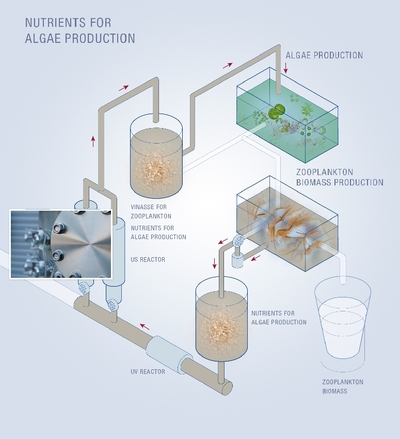Harmonising the production of food and energy
Although biofuels can clearly contribute to energy security and resource efficiency, they can also be sometimes considered controversial. This is primarily because the raw materials used in their production are grown using land that could have been used for food crops. Another issue revolves around the environmental impact caused by certain by-products. Weber Ultrasonics in Germany has developed a process that could provide a solution to these problems.
Called Vin2Food (vinasse for high-grade animal feed and foodstuff production through zooplankton and microalgae), the ultrasonic-based process developed by Weber Ultrasonics uses both the organic and inorganic components of the by-product resulting from the biofuels manufacturing process. These by-products - the so-called vinasse - can be harmful to the environment if left untreated. The issue is compounded even further by the sheer volume of this by-product. Around 7000 L of ethanol can be produced per hectare of sugar cane, but this also creates approximately 84,000 L of vinasse.
Although this by-product can be used as fertiliser, it can cause the soil to be become too acidic. Also, the greenhouse gases, methane and nitrogen oxide which are emitted during storage of the vinasse in anaerobic lagoons can present an issue. Another way to dispose of the vinasse is to thicken it to around one third of its original volume; the vinasse then serves as a component in fertilisers or animal feed (DDGS). However, this disposal concept requires expensive technology and it is an energy-intensive process.
The Weber Ultrasonics industrial process provides a sustainable and economically viable method for recycling of vinasse as a raw material. The planktonic biomass production process comprises four steps.

When the raw vinasse is fed into the system, it is first insonificated using the VinPush 5000 ultrasonic system, which was specially developed by Weber Ultrasonics for this purpose. The system uses multifrequency ultrasonic waves, which allow the organic components contained within the vinasse (eg, yeasts) to be processed for feeding the zooplankton through physical-mechanical and sonochemical effects.
In the second step, the nutrient-packed liquid is then added to the algae production process, where the mineral salts it contains stimulate algae growth. At the same time, the CO2 emitted during bioethanol production is used for cultivation of the microalgae. This makes a contribution to carbon dioxide fixation.
Step three involves feeding the zooplankton with the microalgae that have been cultivated.
In the final step, the algae and zooplankton present in the zooplankton tank, ie, the biomass, are then harvested.
The ultrasound-based process should ideally be established in close proximity to a bioethanol facility and some of the energy required for the production process can be generated using photovoltaic modules.
The zooplankton extracted using the Vin2Food process can be used to produce fishmeal or even as live fish food in shrimp farming. Large quantities of nutrients are required to ensure the success of artificial fish breeding in aquacultures. On its own, processing of ‘fish waste’ simply cannot provide the quantities required.
As such, Vin2Food not only facilitates ecologically sound and economically attractive use of the vinasse, but also makes a contribution to food security.
How Sydney's OS Passenger Terminal slashed its waste costs
Veolia has delivered a custom-designed solution that cut the Overseas Passenger Terminal's...
Sludge treatment: a weighty issue
Sludge dewatering might not be the most glamorous process, but it is a vital part of ensuring...
Getting closer to a circular economy for plastics
A new process that vaporises hard-to-recycle plastics in order to make recycled plastics has been...









